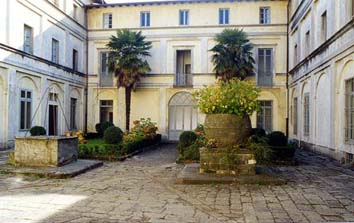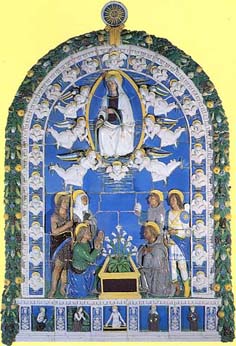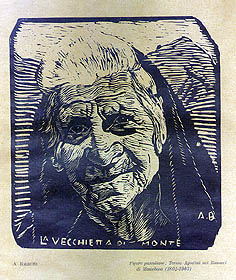 |
| Via
della Torre as seen from Via delle Mura |
Going
up towards the Duomo along the Via del Pretorio you come to the
corner where it meets the other end of Via della Mura. Before and
after this point there are a number of small very narrow streets
or passageways. These 'vicoli' are characteristic of the pattern
of connecting passages which weave through the historical centre
of the town, and which nearly all start from Via di Mezzo (discussed
in the second itinerary).
Along
the right hand side of Via delle Mura, past the Palazzo Gramigna,
and continuing along most of the last part of the Via del Pretorio,
is the historic complex of buildings belonging to the convent known
as the Conservatorio di Santa Elisabetta. This convent was founded
by Michele Turignoli of Barga in the 15th Century for young women
who wished to enter the Third Order of St Francis (papal bull of
Pope Callisto IV in 1456). In 1787, it was transformed into a school
for young girls (conservatorio) by the Grand Duke Pietro Leopoldo
who ordered it to be amalgamated with the Dominican convent in Barga
situated near the church of the Santissima Annunziata on the street
now known as Via di Mezzo. The school, which was run by nuns of
the Order of St. Joseph, provided an education for girls from less
fortunate families, who could study there right up to the level
of a teaching certificate. Giovanni Pascoli defined the school as
a: "...fucina di maestrine di montagna..." (a forge for
hilltown teachers).
Inside
the grounds of the Conservatorio is a magnificent garden with tennis
and basketball courts. The cloister, which is in the classical style,
encloses an area partly paved in stone and part garden where you
will find a huge stone urn containing flowers and evergreen plants,
and an Artesian well which used to provide the water for the domestic
use of the convent.
 |
| The
cloister of the Conservatorio di Santa Elisabetta
|
In
the beautiful little church attached to the Conservatorio there
are a number of important works of art. These include paintings,
a fine choir stall fashioned in wood, and a lovely altar piece
dedicated to the Madonna della Cintola. This latter is in Della
Robbian style but, according to an attribution by Gentilini, it
is actually from the workshop of Benedetto Buglioni. There is
also a 'tondo' in glazed terracotta of the Madonna and Child attributed
to Giovanni Della Robbia.
Also
inside the church is a magnificent wooden crucifix from the French
School of the 13th Century.Further
works of art can be found in the corridors and richly furnished
rooms of the Conservatorio itself, for example, in the so-called
'Red Room'.
 |
| The
Madonna of the Cintola. Glazed
terracotta altar piece attributed to the workshop of Benedetto
Buglioni. |
Next
to the church there is a small gym which was built for the sporting
activities of the school and which is used today by various local
associations.
Turning back to Via del Pretorio, at the point at which it meets
Via delle Mura, you will find, on the corner, a small palazzo
belonging to the Bertacchi family, an old distinguished Barga
family dating back to the times of the Medici. Further up the
Via del Pretorio, on the left hand side, is the back entrance
to the Palazzo Salvi-Balduini, which originally belonged to the
Pieracchi family and then to the Bertacchi. This stone entranceway,
built in classical Medici style, leads to a cloister with a well
inside it, and to the part of the building which was inhabited
by the Balduini family. Inside is an art gallery containing the
works of Adolfo Balduini (1881-1957), the graphic artist, painter,
and sculptor, who exhibited at the Biennale di Venezia, along
with the other Barga artists Magri, Cordati and Vittorini.
 |
| A.
Balduini: "La vecchietta di monte" (Old lady of
the mountain). Woodcut |
next
page
|